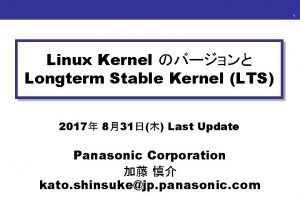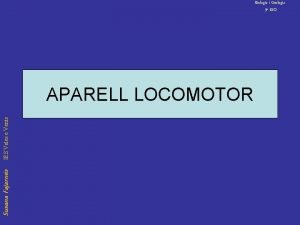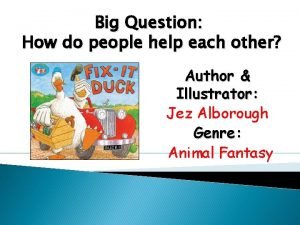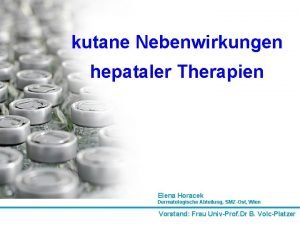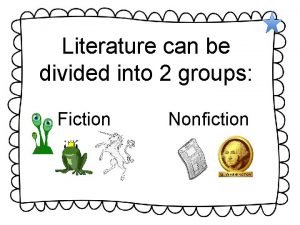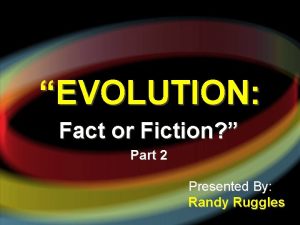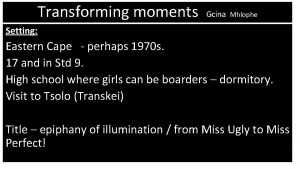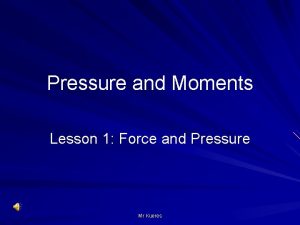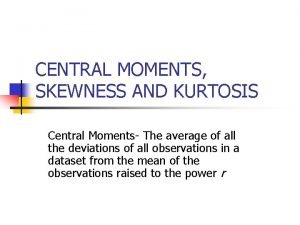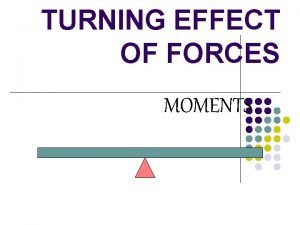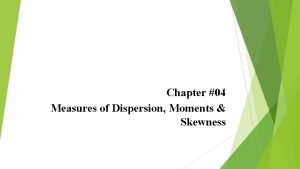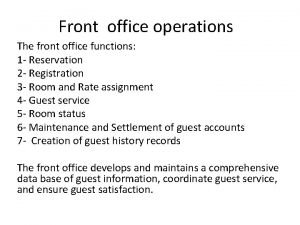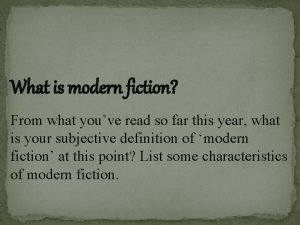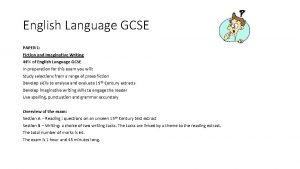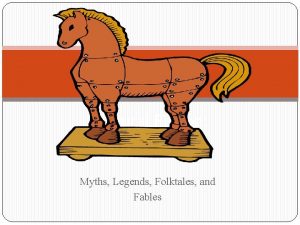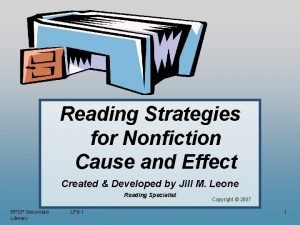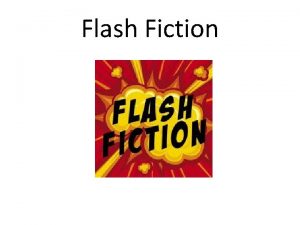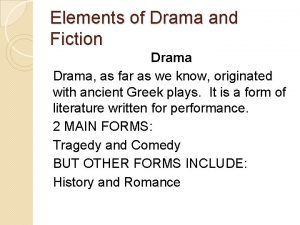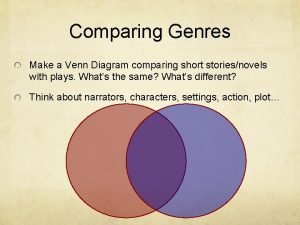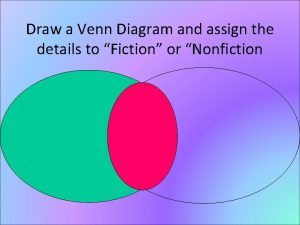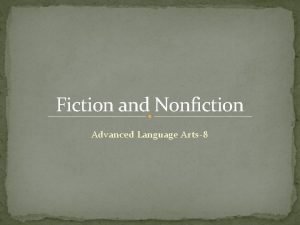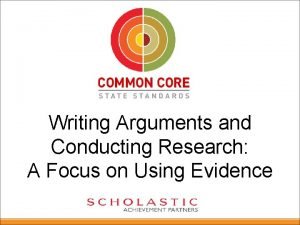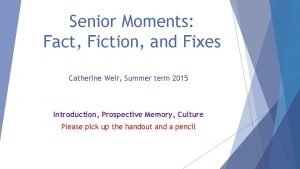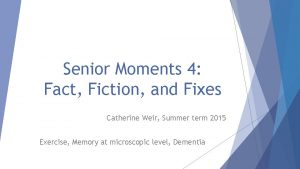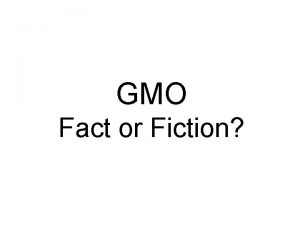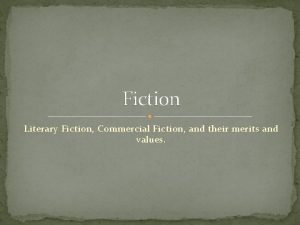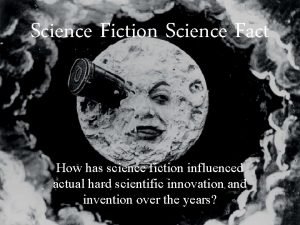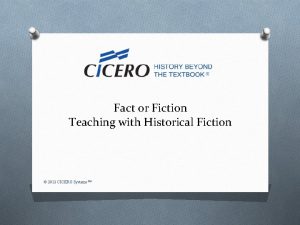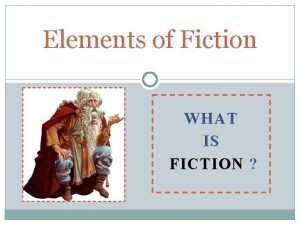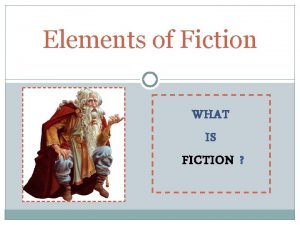Senior Moments 3 Fact Fiction and Fixes Longterm






























- Slides: 30

Senior Moments 3: Fact, Fiction, and Fixes Long-term memory: both Intentional and Unintentional; Levels of Processing Catherine Weir, Summer term 2015

F, f, & F Ø Fact: Long-term memory is made up of several different modules. Ø Fiction: Memories stay the same over the years. Ø Fix: Testing yourself on material while you are learning will lead to better memory.

Review -- from 2 nd Class Information From Environment Ø Working Memory WM Long Term Memory – LTM Working memory has different modules: Central executive (attention to some aspect of environment) o Visual-Spatial sketch pad (visual working memory) o Phonological loop (language-related working memory) o Episodic buffer (part of working memory for combining info) o Ø Ø Working memory findings – Task 2 – write down some fixes o Rapid forgetting o Limit on Memory Span o Primacy: Information presented first tends to be remembered best Working memory improves with module-specific training

How to chunk Ø Take a credit card number (or password, library id, SSN) o 8357 1986 2974 0000 Ø Individual differences, self-references, call on general knowledge Ø Acronyms are chunks CIA – sometimes we are unable to retrieve the original because acronym is all that has been moved into long term memory -- HIPAA

Review from 1 st class Encode, Store, Retrieve for successful memory Levy & Langer: Cultural attitudes Prospective memory – being aware of a previously formed plan at the right time and place o # types of prospective memories: event, activity, time o Retrieval strategies that enhance prospective memories o Effect of interruptions on prospective memories o Task 4: Read the story. If you have a moment, do Task 3.

Basic Ideas about LTM Long-term memory is comprised of several modules – green part of picture. Baddeley, Eysenck, Anderson Another approach to understanding LTM focuses on the encoding part of memory: Levels of Processing. Craik & Lockhart.

Hierarchy of Modules of Long-term Memory (LTM) Long-term memory Implicit Memory (unintentional) Priming Procedures Explicit Memory (intentional ) Conditioning Episodic & autobiographical memory Like many filing cabinets or the room filled with memory storage in the day with mainframe computers. General knowledge (semantic, visual)

1. BRAIN IMAGING evidence that unintentional (implicit) and intentional (explicit) memories are separate. Brain imaging – neural activity in one region of brain for one type of memory and different region for other type of memory. a. Conscious awareness – more activity in prefrontal cortex & hippocampus – Intentional memory (including episodic memory). b. Unintentional memory – striatrum (part of basal ganglia)

2. BRAIN DAMAGE: More evidence for separation of intentional from unintentional memory Brain damage is often limited to specific regions. A patient can lose intentional but not unintentional memory. a. HM is patient whose hippocampus was removed (both L & R). He had poor intentional memory but was similar to controls for unintentional memory. Vandenberghe et al. 2006 b. Parkinson’s patients have damage to striatum (usually, location for unintentional memory). Many Parkinson patients have difficulty with unintentional learning. Wilkinson & Jahanshahi 2007 CAVEAT: Most tasks involve both intentional & unintentional memory.

3. COGNITIVE EVIDENCE: intentional memory and unintentional memory differ a. Age changes: healthy older adults tend to have problems with intentional memory but not with unintentional memory. b. Unintentional learning tends to have less variability than intentional learning. c. People with better intentional memory tend to have higher IQs. Unintentional memory ability is not predictive of general intelligence. CAVEAT: Most tasks involve both intentional & unintentional memory.

Couple of Cognitive Exercises for You

Droodles from Eysenck 2012 Wuzzles or Dingbats

Word Fragment Test (like crossword puzzle) We will have a few moments for you to try to fill in a word that comes to mind when you see these word fragments. Do as many as you can and put them in the cells of the table for Task 4 on your handout. al _ _ n _ c _ p _ on _ _ ht _ ay su _ m _ _ b _ sh _ l _ h _ do _ _ l _ m _ te _ io _ _ n __u_t_y h _ us _ f _ _ t _ ry __r_f_e of _ _ c _ _e_d_w _ urp _ _ _p_d_r

Unintentional Memory Also called Implicit or Nondeclarative Memory

Task 4 Priming after reading stories Ø TEST – word fragment test is a type of recognition test. Ø Answers to word fragment test Ø almanac spoon ashtray summer bashful shadow climate violin country house factory giraffe office Tom meadow Tom purple Lucy spider Lucy If your memory was primed by passage you read, then o If you read the Tom passage: more words in columns 1 & 2 than in columns 3 and 4. o If you read the Lucy passage: more words in columns 3 & 4 than in columns 1 & 2.

PRIMING – one drawer in Unintentional/Implicit Memory storage Priming: better processing of a word or image because it was presented recently. Ø Ø Perceptual priming o Words that fit in the word fragments. o Study showed that words seen just before a task would be more likely to be identified. This happened when the words were presented so fast that they could not be seen clearly. Tulving & Schacter 1990 Conceptual priming o Pictures that are of famous people are more likely identified than unknowns. o Recognition of wuzzles.

PROCEDURAL MEMORY: Another unintentional memory module Ø Examples: driving a car; catching a ball; eating with chopsticks. Ø Learning grammar for language: we know what is correct “She were right”.

Conditioning: another unintentional memory module Ø Classical conditioning – when once bitten by a dog, a person’s heart rate goes up when seeing other dogs, and avoids going within “biting-reach”. Ø Operant conditioning – when learn to (rewarded for) slam car doors because you own a Ford; then you tend to slam all car doors. Unintentional memory reveal prior learning/conditioning.

Explicit / Intentional / Declarative memory

SEMANTIC MEMORY: an intentional memory module General knowledge = semantic memory o Vocabulary of most people -- 20, 000 to 100, 000 words o Storing concepts, ideas, meaning of words, Gettysburg address, names of US states, cultural patterns, and more. We do a task in a moment to illustrate some features of this storage.

Brain regions for different categories of information • Some patients have category-specific amnesia: might show non-living things remembered better than living things – e. g. 90% (briefcase) vs 6% (ostrich). • Brain scans show different regions for different categories of objects: Example of faces (red) vs places (buildings - green).

Several ideas about how semantic memory is organized Example Spreading brain Activation Collins & Loftus, 1975 Or Node Structure Theory Mac. Kay & Burke, 1991 Importance of understanding how semantic memory is organized: often the basis of retrieval. Task 5

(1) I will give you 1 minute to think of a word answering the 8 questions in Set A. Record the number of words in box. (2) I will give you 1 minute to think of a word answering the 8 questions in Set B. Use Task 5 boxes. Set A Set B 1. Fruit starting with p. 1. Fruit ending with h. 2. Animal starting with d. 2. Animal ending with w. 3. Metal starting with i. 3. Metal ending with r. 4. Bird starting with b. 4. Bird ending with n. 5. Country starting with F. 5. Country ending with y. 6. Boy’s name starting with H. 6. Boy’s name ending with d. 7. Girl’s name starting with M. 7. Girl’s name ending with n. 8. Flower starting with s. 8. Flower ending with t.

Remembering names is different from non-names Some research studies show seniors have worse memory for names than younger adults; others do not find age differences. Meeting Mr Farmer or Meeting a Farmer Lori James 2004 o § People recalled occupations better than names (both 20 -year and 70 -year olds). § Large number of associations with nouns § Relatively few associations between name and other information Older adults had relatively more trouble with names than younger adults. Mr Farmer Mr Sutton farmer dentist

Farmer/farmer Paradox

Training to Improve on Name Memory Schmidt, Dijkstra, Berg, Deelman, 1999 Ø Germany – 34 healthy adults (43 to 87 yrs) Ø Groups: Training vs Control – 6 hours over 3 weeks with homework o Ø Control groups – Discussions (6 hrs) about worry on memory & some basics about memory Tests on face/name pictures (target) or reading story (non-target)

Steps in 6 -hour training on names with homework 1. How to give names meaning. Ms Camp or Mr Supramaniam 2. Names were linked to feature of face. Girl Scout nose 3. Names connected to hobby or home of person in photo. Mr Superman loves flying 4. Names combined with photos. Focus on Ms Camp with Girl Scout nose; Mr Superman’s hair looks like a cape. 5. & 6. Practice with retrieval cues using famous people

EPISODIC MEMORY: Intentional memory module Episodic Memory is remembering past events that happened to us. o Self-awareness of this being an event in the past. o Amnesia patients often have good general knowledge but lack episodic tags. o Memory is a constructive process, not necessarily accurate • Select information relevant to current context. • May recall last recall rather than event itself. Bartlett

Evidence-based ways to enhance memory Type of memory Prospective Working Memory Long-term Memory Fixes Favor event-based retrieval cues; rehearse actions for task; imagine doing the task; write it down; avoid interruptions Chunk items, put important stuff 1 st (primacy); avoid interference; practice specific aspects of WM – computer program for VSWM; audio practice for PL etc Retrieval strategy; Find meaningful associations with names; among items; Relate facial feature to image; relate items together with image, method of loci

F, F, & F for Long-term memory Ø Ø Fact: a. Thinking of memory with separate modules describes it well. b. Episodic memories (intentional) tend to be less accurate in older adults. c. Unintentional memories tend to be well-preserved over the years (priming, skills, conditioning). Fiction: Older adults have worse memories than young adults. a. Ø General knowledge (semantic memory) tends to be better in older adults. Fixes: o Training on retrieval strategies for episodic memories will improve memory.
 Linux kernel lts
Linux kernel lts Costelles vertaderes
Costelles vertaderes Mr spuffington fixes it himself
Mr spuffington fixes it himself Years solitary confinement
Years solitary confinement Fixes arzneimittelexanthem
Fixes arzneimittelexanthem What is non fixtion
What is non fixtion Realistic fiction
Realistic fiction Speculative fiction characteristics
Speculative fiction characteristics Contemporary realistic fiction vs historical fiction
Contemporary realistic fiction vs historical fiction Evolution fact or fiction
Evolution fact or fiction Figures of speech used in transforming moments
Figures of speech used in transforming moments Pressure and moments
Pressure and moments Lepokurtic
Lepokurtic Physics turning effect of forces examples
Physics turning effect of forces examples Measure of dispersion moments and skewness
Measure of dispersion moments and skewness Miracles come in moments. be ready and willing meaning
Miracles come in moments. be ready and willing meaning Function of front office in hotel
Function of front office in hotel Alonzo and tracy mourning senior high
Alonzo and tracy mourning senior high Department of health and senior services missouri
Department of health and senior services missouri Modern fiction definition
Modern fiction definition Is english language paper 1 fiction or nonfiction
Is english language paper 1 fiction or nonfiction Elements of science fiction and myths legends folktales
Elements of science fiction and myths legends folktales Marcia was a skilled and capable driver
Marcia was a skilled and capable driver Fiction
Fiction Elements of gothic fiction in the pit and the pendulum
Elements of gothic fiction in the pit and the pendulum Drama microfiction
Drama microfiction Short story and drama venn diagram
Short story and drama venn diagram Fiction and nonfiction venn diagram
Fiction and nonfiction venn diagram What's science fiction
What's science fiction Elements of fiction and nonfiction
Elements of fiction and nonfiction Example of claim of policy
Example of claim of policy
